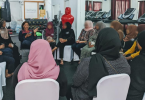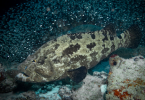Coir rope making or Roanu Veshun (in Dhivehi) is one of the traditional handicrafts in the Maldives. Maldivians use different parts of the coconut palm to produce items for their daily needs. Coir rope was most importantly used in boats and construction of traditional houses.
The coir rope making process is a lengthy process lasting as long as two months or more to produce a single batch of ropes. Coir comes from the husk of the coconut. First, a piece of ironwood (Kuredhi), sharpened at both ends is stuck to the ground and is used to separate the coconut from its husk. This Is locally known as ‘Kaashi Hehun’. The coconut is used for food and other purposes.
The husks separated from the coconut are first made tender by burying them in water. The raw husk of the coconut is buried in where the waves break at the shore to ensure the husks remain wet all the time. In some islands, where swamps are present, these areas are preferred. This is locally known as ‘Bo’nbi Faakurun’. The length of the coir rope making process depends on how long it takes for the coconut husks to become tender. They are kept buried until they become tender enough. Sticks are used to mark the area where the husks are buried.
After about one to two months, the husks are dug up. It is then placed on a hard wooden surface such as that of a log and beaten with a wooden club. This locally known as ‘Bo’nbi Thelhun’. This is done to loosen the fibrous coir strands from the rest of the husk. The coir fibres are then washed with seawater to remove dust and spread in the sun to dry them.
Once they are completely dry, they are ready to be spin into ropes. To make coir rope, a handful of coir is pulled at both ends by hands to separate strands of coir from the coir fibres. Depending on the desired thickness of the coir rope, few strands are taken into the palms and the ends of these strands are joined to the ends of another few strands by spinning between the palms. This method is continued to produce a bundle of coir rope of a determined length. The making of Roanu or coir rope is locally known as ‘Roanu Veshun’. It is the women folks that are mostly involved in doing Roanu Veshun.
Coir rope was not limited to its use in boats and during construction of traditional houses. It was extensively used to make the traditional hammock or ‘Joali’, doormats and also used to make the framework in bed for placing the mattress.
Nowadays coir rope is used for decorative purposes and the production of Maldivian souvenirs. The designs of some buildings such as restaurants come with ostentatiously decorated columns and support wrapped by coir rope, and coconut thatching. Maldivians still use coir rope to make ‘joali’. It is found commonly in the households of islanders.
In the olden days, this was a means of earning a living as coir rope was in high demand and exported to foreign countries. Maldivians exported coir rope to China, Yemen and the Persian Gulf.
Full details are available at the link below:







